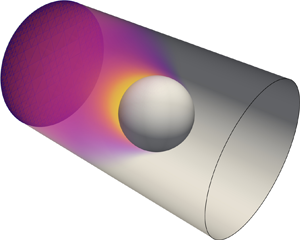Article contents
Confined self-propulsion of an isotropic active colloid
Published online by Cambridge University Press: 23 December 2021
Abstract

To spontaneously break their intrinsic symmetry and self-propel at the micron scale, isotropic active colloidal particles and droplets exploit the nonlinear convective transport of chemical solutes emitted/consumed at their surface by the surface-driven fluid flows generated by these solutes. Significant progress was recently made to understand the onset of self-propulsion and nonlinear dynamics. Yet, most models ignore a fundamental experimental feature, namely the spatial confinement of the colloid, and its effect on propulsion. In this work the self-propulsion of an isotropic colloid inside a capillary tube is investigated numerically. A flexible computational framework is proposed based on a finite-volume approach on adaptative octree grids and embedded boundary methods. This method is able to account for complex geometric confinement, the nonlinear coupling of chemical transport and flow fields, and the precise resolution of the surface boundary conditions, that drive the system's dynamics. Somewhat counterintuitively, spatial confinement promotes the colloid's spontaneous motion by reducing the minimum advection-to-diffusion ratio or Péclet number,  ${Pe}$, required to self-propel; furthermore, self-propulsion velocities are significantly modified as the colloid-to-capillary size ratio
${Pe}$, required to self-propel; furthermore, self-propulsion velocities are significantly modified as the colloid-to-capillary size ratio  $\kappa$ is increased, reaching a maximum at fixed
$\kappa$ is increased, reaching a maximum at fixed  ${Pe}$ for an optimal confinement
${Pe}$ for an optimal confinement  $0<\kappa <1$. These properties stem from a fundamental change in the dominant chemical transport mechanism with respect to the unbounded problem: with diffusion now restricted in most directions by the confining walls, the excess solute is predominantly convected away downstream from the colloid, enhancing front-back concentration contrasts. These results are confirmed quantitatively using conservation arguments and lubrication analysis of the tightly confined limit,
$0<\kappa <1$. These properties stem from a fundamental change in the dominant chemical transport mechanism with respect to the unbounded problem: with diffusion now restricted in most directions by the confining walls, the excess solute is predominantly convected away downstream from the colloid, enhancing front-back concentration contrasts. These results are confirmed quantitatively using conservation arguments and lubrication analysis of the tightly confined limit,  $\kappa \rightarrow 1$.
$\kappa \rightarrow 1$.
JFM classification
- Type
- JFM Papers
- Information
- Copyright
- © The Author(s), 2021. Published by Cambridge University Press
References
REFERENCES
- 11
- Cited by



